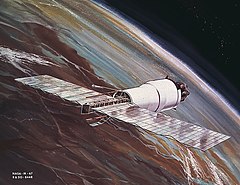Pegasus 1
 | |
| Inne nazwy | Apollo SA-9, Saturn SA-9, S01085 |
|---|---|
| Indeks COSPAR | 1965-009A |
| Państwo | |
| Zaangażowani | |
| Rakieta nośna | |
| Miejsce startu | |
| Orbita (docelowa, początkowa) | |
| Perygeum | 495 km |
| Apogeum | 733 km |
| Okres obiegu | 96,80 min |
| Nachylenie | 31,73° |
| Czas trwania | |
| Początek misji | 16 lutego 1965 14:37:03 UTC |
| Powrót do atmosfery | 17 września 1978 |
| Wymiary | |
| Kształt | walec z bocznymi, wydłużonymi, prostokątnymi tacami. |
| Wymiary | wysokość: 18,6 m, średnica: 3,9 m |
| Masa całkowita | 1451,5 (10450 kg wraz z 2. członem rakiety) kg |
Pegasus 1 − amerykański satelita naukowo-badawczy do pomiaru mikrometeoroidów dla celów związanych z projektowaniem statków Apollo w ramach programu Apollo. Pierwszy statek z serii Pegasus.
Cele misji[1]
- Test działania satelity Pegasus.
- Ocena ilości mikrometeoroidów na niskiej orbicie okołoziemskiej.
Misja
Saturn SA-9, czwarta rakieta wersji Block 2 wystartowała 16 lutego 1965 roku o godzinie 9:37 czasu EST. Był to pierwszy z trzech lotów, których zadaniem było umieszczenie na orbicie satelitów w ramach programu Pegasus. Satelita został umieszczony na orbicie po 631,66 sekundach lotu. Także rozłożenie paneli, które służyły do detekcji mikrometeoroidów zakończyło się sukcesem. Wkrótce satelita zaczął się obracać w tempie 9,8 stopnia na sekundę. Stało się to w czasie wypuszczania tlenu ze zbiornika drugiego stopnia rakiety. Było to najprawdopodobniej spowodowane kolizją strugi tlenu z panelem Pegasusa 1[1]. Ze względu na duże rozmiary, satelita zajmował zarówno przestrzeń w makiecie modułu serwisowego, jak i w drugim stopniu rakiety[1].
Przypisy
Bibliografia
Media użyte na tej stronie
The flag of Navassa Island is simply the United States flag. It does not have a "local" flag or "unofficial" flag; it is an uninhabited island. The version with a profile view was based on Flags of the World and as a fictional design has no status warranting a place on any Wiki. It was made up by a random person with no connection to the island, it has never flown on the island, and it has never received any sort of recognition or validation by any authority. The person quoted on that page has no authority to bestow a flag, "unofficial" or otherwise, on the island.
This image is an artist's conception of the Pegasus, meteoroid detection satellite, in orbit with meteoroid detector extended. The satellite, a payload for Saturn I SA-8, SA-9, and SA-10 missions, was used to obtain data on frequency and penetration of the potentially hazardous micrometeoroids in low Earth orbits and to relay the information back to Earth.
The SA-9 (Saturn I Block II), the eighth Saturn I flight, lifted off on February 16, 1965. This was the first Saturn with an operational payload, the Pegasus I meteoroid detection satellite. SA-9 successfully deployed the Pegasus I, NASA's largest unmarned instrumented satellite, into near Earth orbit.



